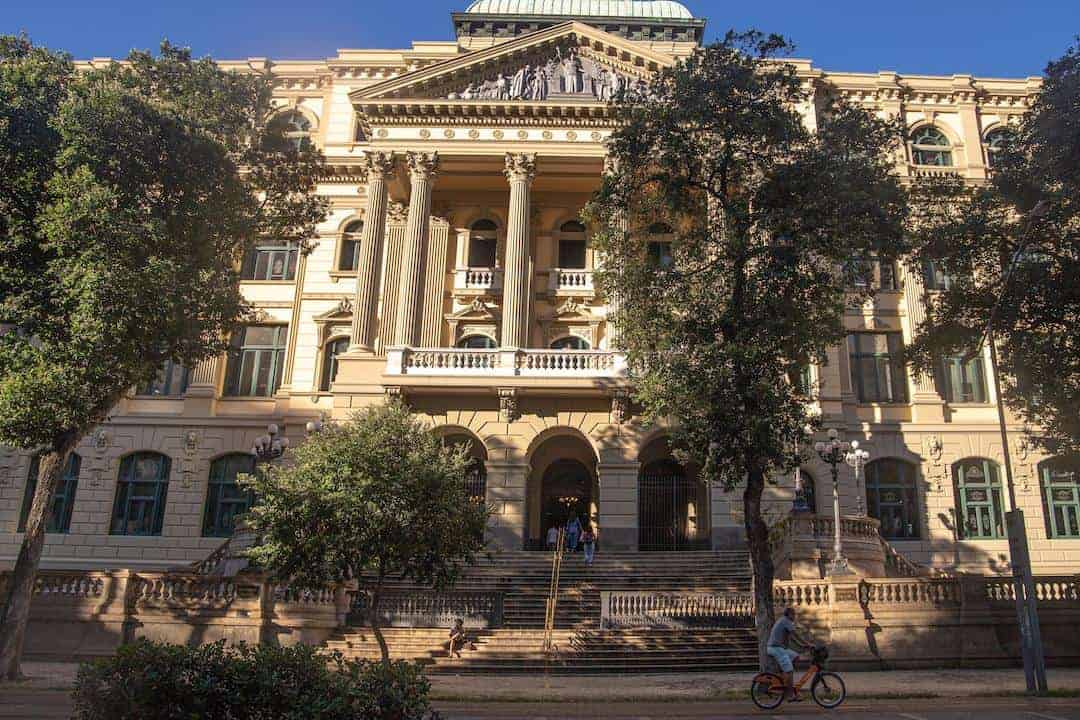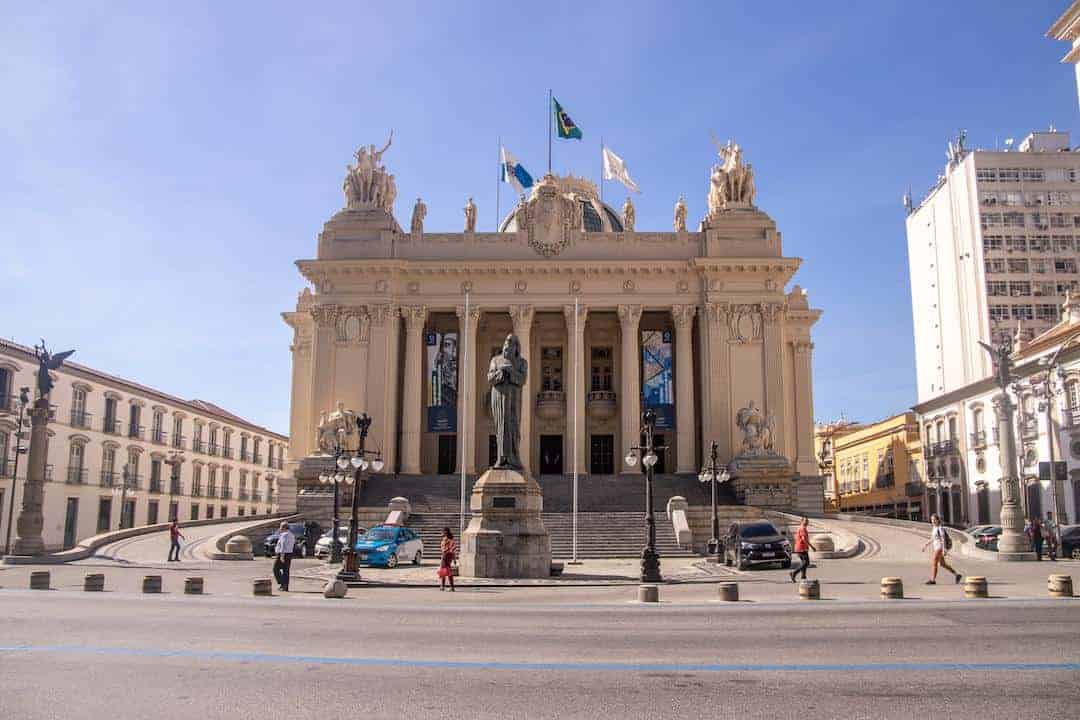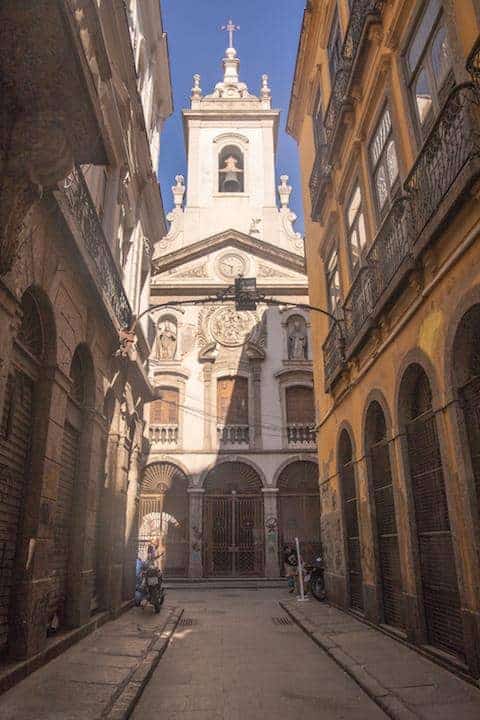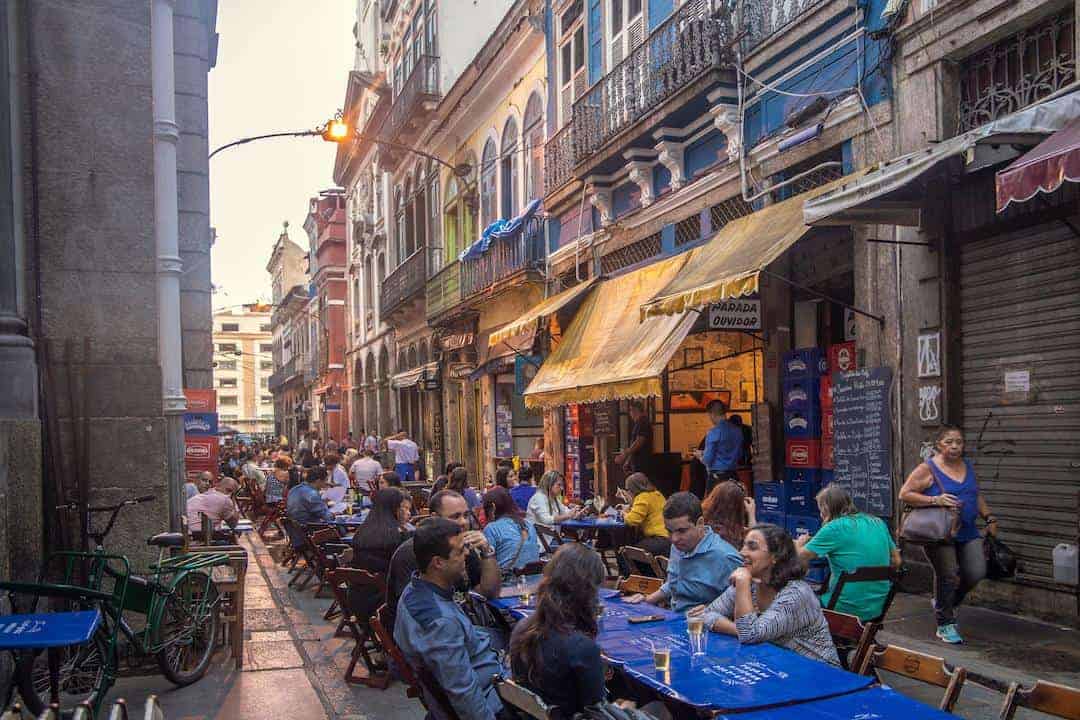In the old streets of downtown Rio de Janeiro, we will explore the history of Brazil from the colonial period to the present day, through the Empire, the years of the Old Republic and the troubled periods under military dictatorships. Each building, from different times and with its own architectural style, tells an important episode of the largest country in Latin America.
Tour Creator
Constance is a travel journalist fascinated with urban history, bred but not born in Rio de Janeiro. She left the city to adventure herself around Europe and South America, writing…Read More Bio »
Rio de Janeiro
GPS-directed
Remote Tour Included
1+hr/2.5hrs(Extended itinerary)
1km/2.5km(Extended itinerary)
Avoid the Crowds
Allows you to explore without having to be shoulder-to-shoulder in a large tour group
Created by an exceptional journalist
Written by a Buenos Aires-raised travel journalist fascinated with urban history
GPS Directions
Easy-to-follow GPS directions to get you from one point to the next on your tour
Highlights include:
Ouvidor Street, Square XV and the Imperial Palace
Remote Tour Included
As with all our tours, a remote tour is included that can be enjoyed from home
Itineraries
Essential Rio De Janeiro – Extended
Essential Rio De Janeiro – Standard
- Carioca Square - Where does the names Brazil, Rio de Janeiro and carioca come from? To begin understanding the country and the city’s history, our starting point is one of the first public areas of the village of São Sebastião do Rio de Janeiro, founded in 1565 on the banks of Guanabara Bay.
- Convent of St. Anthony - When you see the city from the Guanabara Bay, you realize that Rio de Janeiro’s landscape is all about hills and beaches. It may not seem like it nowadays, but the downtown area also had these natural landmarks. The small elevation we see, crowned by the Convent of Saint Anthony, was back in the 16th century an extensive hilltop bordered by a lagoon.
- São Francisco de Paula Square - Uruguaiana street was the limit of the city back in the colonial period. The square, named after the baroque Church of San Francisco de Paula, built in 1801, also has important educational buildings.
- Royal Portuguese Cabinet of Reading - A library and lusophone cultural institution from the 1800s. Considered one of most beautiful libraries in the world, it is richly decorated in Neo-Manueline style, with symbols related to the maritime discoveries period.
- Confeitaria Colombo - This elegant pastry shop was inaugurated in 1884 and its architecture is an example of the Art Nouveau and the Belle Époque of Rio de Janeiro. The furniture is made of rosewood and it is decorated with belgian mirrors and italian marble. It was attended by important Brazilian personalities, such as the maestro Villa-Lobos, the writer Lima Barreto and the presidents Getúlio Vargas and Juscelino Kubitschek.
- Rio Branco Avenue - This is the busiest and most important avenue of Rio’s City Center. It used to be called Avenida Central, or Central Avenue, and was one of the main milestones of the urban changes in the beginning of the 20th century.
- Ouvidor Street - Back to the 19th century, Rua do Ouvidor, located at the heart of Old Rio, was one of the most emblematic streets. Before the construction of Central Avenue, this narrow street was filled with some of the most elegant stores of the city. Nowadays, Rua do Ouvidor is still busy and has a lot of bars, restaurants, stores, among other commercial buildings. It is a very popular spot for happy hours, when well-dressed business man and woman take of their suits and have a nice refreshing chopp (tap beer).
- Our Lady of Lapa of the Merchants Church - Located in the oldest streets of Rio de Janeiro and near to a place where merchants would gather to pray, this quaint little church was built in 1755, but completely redecorated in Rococo style in 1879.
- Commerce Alley - This little alley came around 1740. Over the centuries, the houses, stone sidewalks and cobble stoned street survived. After a fire in the late 18th century, the place acquired a bad reputation, being attended by peddlers, prostitutes and bandits. It took a while, but in the 20th century visitors perception about this old alley finally changed. In the 20s, Carmen Miranda, a Portuguese-born Brazilian samba singer, dancer, Broadway actress, and film star, lived in the house 13. By then, it was becoming a bohemian address. Since 1980 the place has been reinventing itself, with new restaurants and bars in the old mansions, which also serve as scenery for recording TV series set in the 50's.
- Square XV #1 - In 1808, the fate of Rio de Janeiro and the whole country was destined to change. The Portuguese royal family, under the pressure of Napoleon's forces invasion, had to flee Lisbon and live in one of their colonies. In Brazil, there were no elegant palaces, no royal court, no luxury whatsoever. In fact, many places did not even have basic sanitation. The arrival of the frightened king John VI and his mom, the crazy queen Mary I, along with the Portuguese royal court and members of the government, was a big cultural shock. And not only for them, but also for commoners, who had a completely different idea of what nobility should be.
- Square XV #2 - Mestre Valentim was one of the main artists of colonial Brazil. It is his work the main piece of this square, a fountain from 1789, which was used to supply water to the vessels that anchored near the quay of Square XV. In addition to its artistic value, it shows the changes of the square over the last centuries, revealing the successive landfills done here.
- Imperial Palace - In 1821, King John VI and the court returned to Portugal, as the newly constituted Portuguese parliament demanded after winning the Liberal Revolution of Porto
- Tiradentes Palace - The Tiradentes Palace was, at the beginning of the 20th century, the seat of the National Congress. But its history is much older. It was built at the site of the Old Prison, where all those who violated the laws of the Portuguese Crown were sent to: criminals, prostitutes and slaves divided cells with political prisoners.
- National Museum of Fine Arts - This museum was only inaugurated in 1938, but its history begins with the arrival of the Portuguese royal family in 1808. John VI not only came accompanied by an assemblage of european art, which made up the initial nucleus of this collection, but also organized the arrival of several European painters, sculptors and architects to initiate the artistic tradition in the country.
- National Library - The depository of all bibliographic and documentary heritage of Brazil. It is the largest library in Latin America and the 7th largest in the world, with a collection of over 9 million items.
- Cinelândia - The luxurious Municipal Theatre is an opera house built in the beginning of the 20th century to represent the new republican regime and a new era to the elegant capital of Brazil.
- Carioca Square - Where does the names Brazil, Rio de Janeiro and carioca come from? To begin understanding the country and the city’s history, our starting point is one of the first public areas of the village of São Sebastião do Rio de Janeiro, founded in 1565 on the banks of Guanabara Bay.
- Convent of St. Anthony - When you see the city from the Guanabara Bay, you realize that Rio de Janeiro’s landscape is all about hills and beaches. It may not seem like it nowadays, but the downtown area also had these natural landmarks. The small elevation we see, crowned by the Convent of Saint Anthony, was back in the 16th century an extensive hilltop bordered by a lagoon.
- São Francisco de Paula Square - Uruguaiana street was the limit of the city back in the colonial period. The square, named after the baroque Church of San Francisco de Paula, built in 1801, also has important educational buildings.
- Royal Portuguese Cabinet of Reading - A library and lusophone cultural institution from the 1800s. Considered one of most beautiful libraries in the world, it is richly decorated in Neo-Manueline style, with symbols related to the maritime discoveries period.
- Confeitaria Colombo - This elegant pastry shop was inaugurated in 1884 and its architecture is an example of the Art Nouveau and the Belle Époque of Rio de Janeiro. The furniture is made of rosewood and it is decorated with belgian mirrors and italian marble. It was attended by important Brazilian personalities, such as the maestro Villa-Lobos, the writer Lima Barreto and the presidents Getúlio Vargas and Juscelino Kubitschek.
- Rio Branco Avenue - This is the busiest and most important avenue of Rio’s City Center. It used to be called Avenida Central, or Central Avenue, and was one of the main milestones of the urban changes in the beginning of the 20th century.
- Ouvidor Street - Back to the 19th century, Rua do Ouvidor, located at the heart of Old Rio, was one of the most emblematic streets. Before the construction of Central Avenue, this narrow street was filled with some of the most elegant stores of the city. Nowadays, Rua do Ouvidor is still busy and has a lot of bars, restaurants, stores, among other commercial buildings. It is a very popular spot for happy hours, when well-dressed business man and woman take of their suits and have a nice refreshing chopp (tap beer).
- Our Lady of Lapa of the Merchants Church - Located in the oldest streets of Rio de Janeiro and near to a place where merchants would gather to pray, this quaint little church was built in 1755, but completely redecorated in Rococo style in 1879.
- Commerce Alley - This little alley came around 1740. Over the centuries, the houses, stone sidewalks and cobble stoned street survived. After a fire in the late 18th century, the place acquired a bad reputation, being attended by peddlers, prostitutes and bandits. It took a while, but in the 20th century visitors perception about this old alley finally changed. In the 20s, Carmen Miranda, a Portuguese-born Brazilian samba singer, dancer, Broadway actress, and film star, lived in the house 13. By then, it was becoming a bohemian address. Since 1980 the place has been reinventing itself, with new restaurants and bars in the old mansions, which also serve as scenery for recording TV series set in the 50's.
- Square XV - In 1808, the fate of Rio de Janeiro and the whole country was destined to change. The Portuguese royal family, under the pressure of Napoleon's forces invasion, had to flee Lisbon and live in one of their colonies. In Brazil, there were no elegant palaces, no royal court, no luxury whatsoever. In fact, many places did not even have basic sanitation. The arrival of the frightened king John VI and his mom, the crazy queen Mary I, along with the Portuguese royal court and members of the government, was a big cultural shock. And not only for them, but also for commoners, who had a completely different idea of what nobility should be.
Check out a free sample of this tour!
Share this tour
Facebook
Twitter
Pinterest
Get the tour in our app today!
Related Tours
No related posts.









